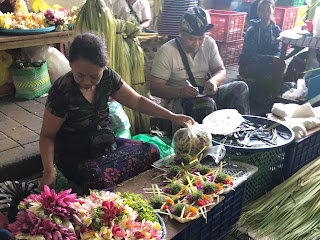Bali Fruit
I've never been a big
fan of fruit. I eat them when I remember and I am very particular in my tastes,
and I never eat a lot. Mostly, I consume fruit because I know it's good for me.
But I could easily live without it.
However, on a tropical
island like Bali, the fruit is a must, whether you want it or not. From the
breakfasts which always start with fruit platters and juices, to the fruit
markets and the vendors outside the temples, from the street vendors in every
single village to the enormous palm trees laden with coconut, everything
invites you to eat fruit. It's also very hot, so I felt the need for something
more watery in my meals.
 Breakfasts always
started with a platter of fruit. We usually had watermelon, honeydew, papaya,
pineapple and an assortment of freshly squeezed juices, using the fruit above
or avocado. There was a certain difference from what I knew about these fruit
from back home (where they were some kind of fresh, but not
just-plucked-from-the-tree fresh), but nothing notable. I concluded that I
still wasn't impressed by papaya, even if it was local, and I still preferred watermelon.
Pineapple in Bali was small and kind of dry (I suppose it also depends on the
season). Aside from breakfast, the rooms in the villas we rented all offered
fruit baskets containing bunches of small bananas, snake fruit, and oranges. I
tried the bananas and found them to be the real deal. They were sweet and
extremely fragrant, like nothing I ever tasted before. At first, I had no idea
how to open and eat the snake fruit, but, thanks to Google, I got the hang of
it.
Breakfasts always
started with a platter of fruit. We usually had watermelon, honeydew, papaya,
pineapple and an assortment of freshly squeezed juices, using the fruit above
or avocado. There was a certain difference from what I knew about these fruit
from back home (where they were some kind of fresh, but not
just-plucked-from-the-tree fresh), but nothing notable. I concluded that I
still wasn't impressed by papaya, even if it was local, and I still preferred watermelon.
Pineapple in Bali was small and kind of dry (I suppose it also depends on the
season). Aside from breakfast, the rooms in the villas we rented all offered
fruit baskets containing bunches of small bananas, snake fruit, and oranges. I
tried the bananas and found them to be the real deal. They were sweet and
extremely fragrant, like nothing I ever tasted before. At first, I had no idea
how to open and eat the snake fruit, but, thanks to Google, I got the hang of
it.
We visited the fruit
market in Ubud on the second day of our stay there, at 6.30 A.M. It was packed
with vendors and customers and easy to get lost in. Most buyers were local
women, who were preparing for the day ahead. In Bali, traditional cooking takes
up a lot of time and it starts very early in the morning. Most of them were
buying lemongrass (which I tasted and liked in almost every type of food in
Bali and which is sold in huge bunches), green bananas, snap peas, and greens.
And, while I am on the subject of the people in the market, I need to take a
moment and describe something.
 I am a freelancer and
have been so for over a year. One of the reasons I wanted to visit Bali is
because it's one of the hottest freelance hubs on the planet and I was
incredibly curious about it. It's debatable whether this is a good or a bad
thing in the long run. The bottom line, the island is a wonderful mixture of
old and new and a place where the traditional and exotic way of living becomes
more accessible and easier to understand for a foreigner. In the Ubud fruit
market, at 7 a.m., I saw an image which perfectly describes the strange mixture
which is Bali: a Caucasian girl, dressed in a black lace long, hippie dress,
bargaining with Balinese fruit vendors among baskets of bananas, mangoes, and
bunches of lemongrass. It was a fleeting image, I only saw it for one second,
but I remember it so well because it struck me how beautiful and symbolical it
was. To me, it stands for the essence of wanderlust.
I am a freelancer and
have been so for over a year. One of the reasons I wanted to visit Bali is
because it's one of the hottest freelance hubs on the planet and I was
incredibly curious about it. It's debatable whether this is a good or a bad
thing in the long run. The bottom line, the island is a wonderful mixture of
old and new and a place where the traditional and exotic way of living becomes
more accessible and easier to understand for a foreigner. In the Ubud fruit
market, at 7 a.m., I saw an image which perfectly describes the strange mixture
which is Bali: a Caucasian girl, dressed in a black lace long, hippie dress,
bargaining with Balinese fruit vendors among baskets of bananas, mangoes, and
bunches of lemongrass. It was a fleeting image, I only saw it for one second,
but I remember it so well because it struck me how beautiful and symbolical it
was. To me, it stands for the essence of wanderlust.
Back to the fruit. I
bought mango, bananas, snake fruit, mangosteen, dragon fruit, and passionfruit.
And I also bought lots of flowers. What impressed me, as I was getting out of
the market, were the tiny, elderly ladies who carried groceries on their heads
and stopped to ask me, with smiling, happy faces: "Flowers?" It's a
mark of the Balinese spirit how welcoming and nice they are, without wanting
anything in return. At the villa, I googled the fruit and learned how to eat
them, in something like a tropical feast. The mango is incredible and it gave
me the feeling that I never knew the real taste (the mango and basil smoothie is to die for, as the two tastes complement and boost each other). The mangosteen, with its soft
texture (similar to that of the lychees) and its fragrant taste, was my
favorite. The snake fruit had a scale-like skin and, on the inside, it
resembled garlic, with its compartments. Each compartment held a seed, covered
in the white flesh. It was drier than mangosteen and left an acid, astringent
feeling. The taste was sour-ish and somewhat sweet, but it lacked the explosive
fragrance of the mangosteen. Dragon fruit looked incredible, both on the
outside and on the inside. We had the pink kind. On the outside, it had pink
and green skin, with small, soft spikes. On the inside, it was flamboyantly
pink, with black seeds which contrasted beautifully. But, after this
spectacular look, the taste was disappointing. It was bland, almost flavorless,
not very different from eating beetroot. Passion fruit, which resembled a
bigger plum, puzzled me the most until I got to taste its flavored, jelly-like,
green and delicious flesh.
 I bought jackfruit as
we were leaving Pura Tirtha Empul Temple. As the fruit is gigantic and hard to
open, we were glad to find it in small containers, ready to eat. It has large
chunks of yellowish, stringy flesh surrounding a large black seed. The flesh
has long fibers and is somewhat sour, somewhat sweet and astringent. It's drier
than other fruit and the flavor is mild. Because of the fiber, the texture is
kind of chewy. I bought green coconuts on the beach, in Jimbaran, and Kuta. I
love coconut water and its subtle flavor and to drink it right out the fresh
coconut was great. But in Bali, during the rainy season, coconuts are so large
and so full of water, that I was unable to finish one. I also liked the mushy
young coconut flesh, with its soft taste and oily texture. It was something I
had never tasted before.
I bought jackfruit as
we were leaving Pura Tirtha Empul Temple. As the fruit is gigantic and hard to
open, we were glad to find it in small containers, ready to eat. It has large
chunks of yellowish, stringy flesh surrounding a large black seed. The flesh
has long fibers and is somewhat sour, somewhat sweet and astringent. It's drier
than other fruit and the flavor is mild. Because of the fiber, the texture is
kind of chewy. I bought green coconuts on the beach, in Jimbaran, and Kuta. I
love coconut water and its subtle flavor and to drink it right out the fresh
coconut was great. But in Bali, during the rainy season, coconuts are so large
and so full of water, that I was unable to finish one. I also liked the mushy
young coconut flesh, with its soft taste and oily texture. It was something I
had never tasted before.
I left the best for
last. Before leaving for Bali, I found out about durian. There are entire
online blogs dedicated to what is called "the king of fruit". I also
knew that it smells awful and that many people cannot stomach it, because of
the smell. I also knew that it tastes different, depending on the person. So I
was intrigued, to say the least. I smelled it after arriving on the island and
I must say that it is truly something unique. Banned in airplanes and hotels,
durian smells like rotting onions and garlic. The odor is horrific. It grows on
huge trees, like jackfruit, and it is covered in hard spikes. Animals enjoy it
and monkeys can open it and scoop out the flesh. I was very happy to find it in
a supermarket, packaged and ready to eat. From all the fruit I had in Bali,
durian was the most expensive (all the other fruit were extremely cheap, but
the ready-to-eat durian cost about 25$/kilo)
We took the fruit
outside and opened the container. The smell was very strong and the first sight
of the fruit's texture didn't do it any good. It looked like rotten cheese
(yellow, not blue) and it smelled like 3-days old garbage. We must have been
very curious to try and eat it. One of my friends couldn't get past the initial
taste, no matter how hard he tried. At first, durian tastes as it smells, so it
kind of feels like eating, well...garbage. But after a few seconds, something
happens. The taste of onion changes into something unique, like buttered mango,
like a soft and sweet pudding that is so flavored that you can't stop eating.
My husband told me that to him, durian didn't taste like mango, but like
something resembling a pineapple. My daughter didn't like it and, to my other
friend, it was neutral. The most amazing thing, however, it how much the taste
persisted on my lips, no matter what I ate afterward. Up until the evening, I
could taste the sweet flavor. To my horror, in the evening there was half an
hour when I only tasted the initial onions and garlic, but it subsided pretty
quick. I was left with the pleasant memory of the mango flavor.
Although I am not a fan
of fruit, I'm certain that if I were to live in Bali or somewhere close to the
Equator or the tropics, I would become one. And I probably would have a
healthier lifestyle.






